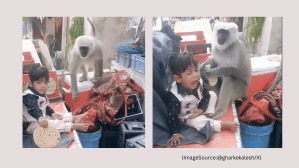UPSC Prelims 2025 Special: Revision Checklist for important Environment topics that aspirants must review for their exams
UPSC CSE Prelims 2025: Environment has become a key focus in UPSC Prelims, often influencing the cutoff. With Prelims exam around the corner, are these crucial topics on your radar? Tick them off your list.
 Here’s a must-check list of key environment topics to revisit in your notes or compilations. Don’t miss them during your final revision. (Freepik AI generate image)
Here’s a must-check list of key environment topics to revisit in your notes or compilations. Don’t miss them during your final revision. (Freepik AI generate image)Are You Prelims Ready? The UPSC Civil Services Preliminary Examination 2025 is scheduled for May 25. With environmental issues increasingly shaping global policies and national priorities, a solid grasp of Environmental topics has become indispensable for aspirants preparing for the UPSC Prelims 2025. Here’s a must-check list of key environment topics to revisit in your notes or compilations. Don’t miss them during your final revision.
1. International Big Cat Alliance
— The International Big Cat Alliance (IBCA), launched by Prime Minister Narendra Modi in 2023 for the global conservation of seven big cats, formally became a full-fledged treaty-based intergovernmental organization.
— The framework agreement entering into force marks the official start of the IBCA’s operations, activities, and programmes as mandated. It can now establish its governing bodies, secretariat, and administrative structures. 27 countries, including India, have consented to join IBCA.
— The IBCA is an initiative launched by Prime Minister Narendra Modi in April 2023 in Mysuru, commemorating the 50th anniversary of Project Tiger. The objective of the IBCA is to ensure cooperation for the conservation of seven big cats: lion, tiger, leopard, cheetah, snow leopard, jaguar, and puma, and enhance knowledge exchange and threats associated with them.
To read more: Knowledge Nugget: Importance of the International Big Cat Alliance for UPSC Exam, Knowledge Nugget | India and International Big Cat Alliance: All you need to know for UPSC Exam
2. Sustainable finance for tiger landscapes conference
— Tiger habitats are critical for preserving biodiversity, sequestering carbon, and supplying resources to nearly 100 million people. Tiger protection is also vital to the Global Wildlife Program (GWP), which works with eight tiger range countries on issues such as preventing the illegal trade in tiger parts, promoting human-tiger coexistence, and restoring and connecting tiger ecosystems.
— The GWP, supported by the Global Environment Facility and led by the World Bank, was pleased to sponsor the Sustainable Finance for Tiger Landscapes Conference in Bhutan.
— The Sustainable Finance for Tiger Landscapes Conference brought together 200 participants from tiger range nations, business and public sector funders, development partners, and conservation non-governmental organisations (NGOs) to debate creative ways to finance tiger landscape conservation sustainably.
(Source: World Bank)
3. Man and the Biosphere (MAB) programme
— The Man and the Biosphere (MAB) programme is UNESCO’s flagship initiative for biodiversity conservation and sustainable development, focussing on improving people’s relationships with their ecosystems.
— The Man and the Biosphere (MAB) programme is an intergovernmental scientific initiative that seeks to build a scientific foundation for improving the relationship between people and their ecosystems.
— The World Network of Biosphere Reserves is a dynamic and participatory network of exceptional places maintained by UNESCO’s Man and the Biosphere (MAB) Programme.
4. The State of the World’s Mangroves
— This 2024 edition of the State of the World’s Mangroves emphasises the significant progress made on numerous fronts to protect these ecosystems.
— Mangroves are widespread in tropical regions such as Southeast Asia, northern Australia, Equatorial Africa, and the low-latitude Americas.
— They play an important role in erosion prevention by absorbing wave movements. They also serve as key biodiversity hotspots.
— Pichavaram mangrove forest of Tamil Nadu is one of India’s largest mangrove ecosystems, lying between the significant estuaries of the Vellar and Coleroon rivers. The site includes littoral and swamp forest habitats.
— The Global Mangrove Partnership (GMA) is the leading partnership working to save and restore the world’s mangroves. Its 100+ member organisations are spread across 30 countries and are active in many more.
(Source: http://www.mangrovealliance.org)
5. Rat-hole mining
— Rat-hole mining, a method of extracting coal from narrow, horizontal seams, is common in Meghalaya. The term “rat hole” refers to narrow pits dug into the ground, usually only large enough for one person to descend and extract coal.
— After digging the pits, miners use ropes or bamboo ladders to descend to the coal seams. The coal is then physically removed with rudimentary instruments like pickaxes, shovels, and baskets.
— Rat hole mining causes severe safety and environmental risks. Mines are often unregulated, with no safety measures such as sufficient ventilation, structural support, or worker protective equipment. Furthermore, the mining process can result in land degradation, deforestation, and water contamination.
6. India State of Forest Report (ISFR) 2023
— The ISFR is produced biennially and entails mapping the country’s forest cover with satellite data.
— The ISFR uses data derived from wall-to-wall mapping of India’s forest cover using remote sensing techniques to plan and formulate policy in the forest management, forestry, and agroforestry sectors.
— India’s green cover has surpassed the 25% mark, with forest (21.76%) and tree (3.41%) covering 8,27,357 square kilometres (25.17%) of the country. Of this, 4,10,175 square kilometres are designated as thick forests.
— The net forest cover increased by 156.41 sq km between 2021 and 2023, bringing the geographical area under forest cover to 21.76 percent, a mere 0.05 percent increase from the 2021 assessment. With the increased net forest area, the total area under forest cover is currently 7,15,342.61 square kilometres.
— The tree cover has increased the most dramatically. It grew from 2.91% in 2021 to 3.41% in 2023, resulting in an expansion of 1,285.4 square kilometres. The overall green cover has expanded by 1,445.81 square kilometres since 2021, accounting for 25.17 percent of the geographical area.
To read more: Knowledge nugget of the day: India State of Forest Report 2023
7. Plant cover across the Antarctic Peninsula
— According to a new study, plant cover on the Antarctic Peninsula, a long, mountainous extension of Antarctica that extends north towards South America, has increased by more than tenfold in recent decades as temperatures have risen.
— A 2023 study published in the journal Nature Climate Change discovered that the continent is warming twice as rapidly as the world average, at a pace of 0.22 to 0.32 degrees Celsius per decade.
— The Antarctic Peninsula is warming five times faster than the global average, making the situation worse than elsewhere in Antarctica. The average temperature on the Antarctic Peninsula has increased by nearly 3 degrees Celsius since 1950.
8. Cloud chamber
— The government-launched Mission Mausam aspires not just to improve weather forecasting in the country, but also to manage certain weather events, such as rainfall, hail, fog, and, subsequently, lightning strikes.
— India is establishing a first-of-its-kind cloud chamber at the Indian Institute of Tropical Meteorology (IITM), Pune.
— A cloud chamber resembles a closed cylindrical or tubular drum into which water vapour, aerosols, and other materials are pumped. A cloud can form inside this chamber when the humidity and temperature are just right.
— The objective of establishing a convective cloud chamber is to gain a better understanding of cloud physics under conditions commonly affecting Indian weather systems.
— Cloud physics is the study of cloud behaviour under normal and extreme conditions; intra-particle interactions within a cloud; the formation of rain droplets and ice particles; the influence of moisture added into the atmosphere by cyclones or low-pressure systems; and interactions between different cloud layers, among other things.
9. Permafrost
— It is any ground that has been frozen—32°F (0°C) or colder—for at least two years. These continuously frozen fields are especially abundant in mountainous places and at higher latitudes, particularly around the North and South Poles.
— Permafrost covers a wide area of the Earth. Permafrost covers over 25% of the Northern Hemisphere’s geographical area. Although the Earth is frozen, permafrost zones do not always have snow. It is composed of soil, rocks, and sand kept together by ice. The soil and ice in permafrost remain frozen all year.
— Permafrost soils contain high quantities of organic carbon—a material remaining from dead plants that couldn’t break down, or rot away, due to the cold. Lower permafrost layers contain soils made mostly of minerals.
10. Methane
— Methane, a strong greenhouse gas, traps heat 80 times more effectively than carbon dioxide during a 20-year period.
— Wetlands emit methane as soil bacteria break down carbon-rich plant matter, a process accelerated by rising temperatures and increased wetland area due to floods.
— From 2020 to 2022, methane concentrations in the atmosphere reached their highest levels since 1980. According to studies, tropical regions are mostly responsible for the increase, with the Congo, Southeast Asia, the Amazon, and southern Brazil contributing significantly.
11. Bioluminescence
— It is the ability of a living creature to generate and radiate light. This phenomenon is unusual in terrestrial ecosystems but prevalent in marine environments.
— Many marine animals, including bacteria, algae, jellyfish, worms, crabs, sea stars, fish, and sharks, can create their own light. Deep-living and planktonic creatures exhibit higher luminescence than shallow species. Furthermore, the appearance of bioluminescent light varies depending on the environment and the creature in which it is present.
— According to NOAA, bioluminescence is the product of an enzyme reaction. An enzyme accelerates a chemical reaction by assisting a substrate in reacting. The enzyme is reused in the process rather than being converted into another molecule.
To read more: Knowledge nugget of the day: Bioluminescence
12. Deep Sea Mining
— It involves removing mineral deposits and metals from the ocean’s seabed.
— There are three types of such mining: taking deposit-rich polymetallic nodules off the ocean floor, mining massive seafloor sulphide deposits and stripping cobalt crusts from rock.
— These nodules, deposits and crusts contain materials, such as nickel, rare earths, cobalt and more, that are needed for batteries and other materials used in tapping renewable energy and also for everyday technology like cellphones and computers.
13. Pantanal wetlands
— South America is witnessing its worst forest fire season in nearly two decades, breaking a previous record for the number of blazes seen in a year.
— Brazil, the continent’s largest country, has been affected the worst, accounting for 60% of the region’s current fires.
— Three of the world’s six largest ecosystems—the Amazon, the Cerrado (the world’s most biodiverse savanna), and the Pantanal wetlands—have been badly impacted.
14. Concentration of fluoride in groundwater
— Excess fluoride increases the risks of disease conditions like skeletal fluorosis, accelerates the rate of dental decay and can cause other human health hazards, especially among children.
— Even though fluoride is among the many minerals found naturally in groundwater, the nationally permissible limit is 1.50 milligrams/litre. Contamination over 1.50mg/litre is deemed unfit for drinking purposes.
— Fluoride is discharged and mixed with groundwater as a result of the leaching and dissolving of fluoride-bearing minerals in the host water aquifers.
— The average fluoride concentration in groundwater was greater in dry, western Indian areas. Rajasthan topped the charts, with pre-monsoon concentrations of 1.41mg/litre and post-monsoon concentrations of 1.44mg/litre, both of which were near to India’s maximum allowable limit.
15. Soil health card
— The soil health card informs farmers about the nutritional state of their soil and recommends the right nutrient dosage to improve its health and fertility.
— The adoption of a soil health card has helped farmers significantly cut production costs while increasing yield. The soil health card depicts the soil’s macronutrient and micronutrient levels.
— Macronutrients include nitrogen, potassium, and phosphorus, whereas micronutrients include boron (B), copper (Cu), iron (Fe), manganese (Mn), and zinc. The soil’s physical properties include organic carbon (OC) and electrical conductivity (EC).
16. Cyanobacterial engineered living material (C-ELM)
— The biomaterial, known as a cyanobacterial engineered living material (C-ELM), contains living cyanobacteria within translucent panels that can be put on the inner walls of buildings. As microorganisms grow through photosynthesis, they absorb CO2 from the atmosphere.
— A kilogramme of C-ELM can collect up to 350g of CO2, whereas the same amount of ordinary concrete would emit around 500g. A wall covered with 150 square metres of solar panels could trap approximately one tonne of CO2.
17. Sea Groynes
— A groyne is a stiff hydraulic structure formed from an ocean coastline (in coastal engineering) or a river bank that disrupts water flow and restricts sediment migration.
— Groyne promotes beach widening, which helps to preserve an appealing beach environment that is valuable for recreation and tourism.
— It also holds silt, resulting in beach broadening, reduces erosion, and more wave energy dissipation. It provides a strong structure for the long-term stabilisation of coasts exploited for social activities.
(Source: http://www.ctc-n.org)
18. High Seas Treaty
— The treaty aims to reduce pollution while also conserving and promoting the sustainable use of biodiversity and other marine resources in ocean seas.
— Because the high seas are outside of any country’s national jurisdiction, the treaty is also known as the Biodiversity Beyond National Jurisdictions Agreement (BBNJ). It is properly known as the Agreement on the Conservation and Sustainable Use of Marine Biological Diversity in Areas Beyond National Jurisdiction.
— The treaty only applies to oceans that are not under the jurisdiction of any country. National authorities typically extend up to 200 nautical miles (370 kilometres) from the coastline, forming exclusive economic zones, or EEZs.
— The treaty also makes it mandatory to carry out a prior environmental impact assessment (EIA) for any activity that is potentially polluting or damaging to marine ecosystems, or to conservation efforts.
— The High Seas Treaty seeks to achieve three substantive objectives:
(i) Conservation and protection of marine ecology;
(ii) Fair and equitable sharing of benefits from marine genetic resources; and
(iii) Establishment of the practice of mandatory environmental impact assessments for any activity that is potentially polluting or damaging to the marine ecosystem.
19. Species/plants in News
a. Rhino
— The International Rhino Foundation (IRF) released its annual State of the Rhino report on World Rhino Day, 22nd September, to highlight the risks to and promote awareness for the five rhino species.
— Rhino poaching in Africa increased by 4% between 2022 and 2023.
— White rhino populations in South Africa are increasing despite poaching.
— The greater one-horned rhino can be found in northern India and southern Nepal, in riverine (floodplain) grasslands and associated woods.
— Kaziranga National Park, a World Heritage Site, is famed for thereat Indian one-horned rhinoceros. The topography of Kaziranga includes sheer forest, thick elephant grass, rough reeds, marshes, and tiny lakes. It was declared a national park in 1974.
IUCN Status: Vulnerable (One-horned Rhino)
IUCN Status: Critically Endangered (Sumatran Rhino)
(Source: rhinos.org)
b. Great Indian Bustard (GIB)
— The Compensatory Afforestation Fund Management and Planning Authority (CAMPA) approved Rs 56 crore funding for the next phase of the conservation program of the Great Indian Bustard (GIB) and the Lesser Florican for the 2024-2029 period.
— The Bustard and Lesser Florican are both critically endangered species. Only 140 Bustards and less than 1,000 Lesser Floricans survive.
— The Great Indian Bustard is a large bird found only in India. It is known to be a key indicator species of the grassland habitat, which means its survival also signals the health of grassland habitats.
Habitat: mainly Rajasthan and Gujarat
c. Camel
— The United Nations has named 2024 the International Year of Camelids (IYC 2024). The Year highlighted how camelids are critical to the livelihoods of millions of households in harsh situations in over 90 countries, notably Indigenous Peoples and local communities.
— Camelids play a vital role in furthering the Sustainable Development Goals (SDGs) for hunger relief, extreme poverty elimination, women’s empowerment, and the sustainable use of terrestrial ecosystems.
— The Indian camel’s IUCN status is Endangered.
d. Indian Flapshell Turtle
— The Indian Flapshell Turtle is a small softshell turtle with a carapace length of up to 350 mm. Nesting often begins in late summer and continues through the monsoon season, which lasts from July to November.
— These species live in a wide range of aquatic habitats, including rivers and streams, reservoirs, marshes, ponds, lakes, and even salt marshes, rice fields, gutters, and canals in urban areas
— It is ubiquitous in brackish water lagoons on India’s east coast and is frequently seen in irrigation canals and tanks, as well as stagnant paddy fields.
Distribution: India, Bangladesh, Myanmar, Nepal and Pakistan.
— Primary amebic meningoencephalitis (PAM) is a rare brain infection that is caused by Naegleria fowleri. It is a free-living amoeba or a single-celled living organism.
— Naegleria fowleri lives in warm fresh water and soil all over the planet. It infects people by entering the body through the nose.
— Naegleria fowleri enters the body through the nose, generally while people are swimming. It then travels to the brain, destroying brain tissue and inducing edoema. Notably, humans cannot become infected with Naegleria fowleri by ingesting water contaminated with the amoeba.
f. Moulmein Rosewood
— The Moulmein Rose Wood (Milliettia ovalifolia) tree’s stunning pink and purple blossoms are best seen in the spring.
— The Moulmein Rosewood, a small to medium-sized tree native to Indo-China and the Malayan regions, is plentiful in the forests of Dehradun and the Shivalik hills.
— It is a deciduous tree that is commonly planted along avenues for ornamental purposes and is ideal for parks. However, according to the ‘Tree Directory of Chandigarh’, its economic benefits include use as a fish and arrow poison and an insecticide.
— Throughout the spring and early summer, the Moulmein Rosewood’s blushing pea-shaped lilac and mauve blossoms appear as jewels on a string. They bloom from April to May. It is a resistant and sturdy tree that can thrive in practically any type of soil as long as it is well-drained.
g. Orangutans
— Malaysia, the world’s second-largest palm oil producer, has faced significant pressure to make its palm oil sector more sustainable. The industry has been related to deforestation, which results in the loss of habitat for orangutans.
— These apes live in the rainforests of the Borneo and Sumatra islands, which are shared by Malaysia, Indonesia, and Brunei. According to a World Wildlife Fund estimate, the orangutan population is currently around 120,000 and is under threat from fast deforestation, mostly caused by palm oil plantations.
— All three species of orangutan, Bornean orangutan, Sumatran orangutan, and Tapanuli orangutan are classified as Critically Endangered by the International Union for Conservation of Nature (IUCN).
h. Golden langur
— Golden langur, also known as “Sonali Bandar” locally, is confined between the Sankosh River in the west, Manas in the east, the Brahmaputra in the south, and the mountains of Bhutan in the north.
— It is an endangered primate found only in northwestern Assam, India, and southern Bhutan.
— Golden langurs (Trachypithecus geei) are members of the colobines (subfamily Colobinae), a big Old World monkey family. Colobines are mostly leaf-eating monkeys with ruminant-like multi chambered stomachs.
— Golden langurs are listed as a Schedule-I species in the Indian Wildlife Protection Act (1972).
i. Miombo Forests
— The United Nations Food and Agriculture Organisation (FAO) and the Italian Agency for Development Cooperation (AICS) have signed two agreements to conduct initiatives aimed at safeguarding the miombo forest and enabling trade along Mozambique’s border with Zimbabwe.
— The Miombo biome comprises tropical and subtropical grasslands, bushlands, and savannahs.
— Miombo woodland is a huge African dryland forest ecosystem spanning almost 2.7 million square kilometres in southern Africa, encompassing Angola, the Democratic Republic of the Congo, Malawi, Mozambique, Tanzania, Zambia, and Zimbabwe.
(downtoearth.org.in)
20. Terms/committee/schemes/initiatives in news
a. Kasturirangan Committee
— Kasturirangan, a well-known space scientist who also served in the Rajya Sabha and on the erstwhile Planning Commission, died in Bangalore. He was 84 years old and had been suffering from age-related difficulties for the past two years.
— He chaired two committees whose reports resulted in important policy changes. His research on the ecology of the Western Ghats, which is largely a review of an earlier report by an environmentalist Madhav Gadgil-led team, serves as the foundation for efforts to restrict human activity in certain parts of the Western Ghats. Kasturirangan also led the group that recommended the New Education Policy.
Recommendations of the Kasturirangan committee report
— The Kasturirangan committee report proposes 37 per cent of the total area of Western Ghats, which is roughly 60,000 square kilometres, to be declared as eco-sensitive area (ESA). Out of this, 20,668 sq km of the area falls in Karnataka covering 1,576 villages.
— The report recommended a blanket ban on mining, quarrying, setting up of red category industries and thermal power projects.
— It also stated that the impact of infrastructural projects on the forest and wildlife should be studied before permission is given for these activities. It also stated that the UNESCO Heritage tag is an opportunity to build global and domestic recognition of the enormous natural wealth that exists in the Western Ghats.
b. COP 29
(i) Declaration on Reducing Methane from Organic Waste
— Recognising that by reducing methane emissions in all relevant sectors, primarily in the fossil energy, agricultural, and waste sectors, by at least 30% below 2020 levels by 2030, the world has the potential to avoid projected global warming by at least 0.2°C by 2050, as outlined in the Global Methane Assessment, this action is critical to keeping global average temperatures below the 1.5°C threshold.
— Noting that methane in the waste sector is the rapidly rising source of anthropogenic methane emissions, resulting mostly from the decomposition of organic waste in landfills, open dumps, and wastewater, and contributes about 20% of anthropogenic methane emissions.
— India is not a signatory to the COP29 Declaration on Reducing Methane from Organic Waste.
(ii) Green Energy Pledge: Green Energy Zones and Corridors
— To collectively double the global average annual rate of energy efficiency improvements from around 2% to over 4% every year by 2030, and to put the principle of energy efficiency as the “first fuel” at the core of policymaking, planning, and major investment decisions, as well as the call on Parties in the outcome of the first global stocktake under the Paris Agreement to contribute to the global efforts of transitioning away from fossil fuels in energy systems in a just, orderly and equitable manner.
(iii) Baku Initiative for Climate Finance, Investment and Trade (BICFIT) Dialogue
— BICFIT Dialogue builds on the growing momentum around the mutually reinforcing role of climate finance, investment, and trade in solving the intersectional issues of climate change and sustainable development, which was acknowledged at COP26, COP27, and COP28.
— It is a COP29 Presidency initiative, co-facilitated by UN Trade and Development (UNCTAD) and UN Development Programme (UNDP), in collaboration with the World Trade Organisation (WTO), International Trade Centre (ITC), and the respective COPs of the UN Framework Convention on Climate Change.
— This effort is optional, open to all Parties and observers, and aims to promote information sharing, mutual learning, and cooperation among ministries, governments, and other stakeholders.
(iv) Climate Finance Action Fund
— The CFAF is part of a large package of proposals that Azerbaijan has prepared for inclusion in the final outcome of COP29 (29th edition of the Conference of Parties to the UN Framework Convention on Climate Change).
— The Climate Finance Action Fund (CFAF) would seek “voluntary” contributions from fossil-fuel producing countries and businesses, with Azerbaijan, a petroleum country, making the first payment.
— CFAF will serve as a catalyst for public-private partnerships, activating the private sector and reducing investment risk. It will provide off-take agreement guarantees to small and medium-sized renewable energy providers, as well as first-loss finance for green industrial projects.
(Source: cop29.az)
c. Article 6 of the Paris Agreement
— The 29th United Nations Climate Change Conference (COP29) in Baku, Azerbaijan, ended with disappointment. It is regarded as a failed COP as one aspect of the compromise agreement was the implementation of Article 6 of the Paris Agreement.
— Article 6 of the Paris Agreement outlines how countries can work together voluntarily to meet their climate commitments. It promotes international cooperation in combating climate change and unlocks financial assistance for developing countries.
— Article 6 allows governments to transfer carbon credits obtained from reducing greenhouse gas emissions to help one or more countries fulfil their climate commitments.
(Source: unfccc.int)
d. Emissions Gap Report 2024
— According to a new United Nations estimate, China and India, two of the top three emitters, will increase their greenhouse gas emissions by 5.2% and 6.1%, respectively, in 2023.
— The UN Environment Programme’s annual Emissions Gap Report warned that the Paris Agreement goal of limiting global temperature rise to 1.5 degrees Celsius would be “gone within a few years” and that the 2 degree Celsius threshold could be breached unless countries dramatically scale up their climate actions to reduce global emissions in two years.
— It was established in 1991 as a voluntary and non-binding initiative to promote the labelling of household and consumer items based on environmental and quality criteria.
— The Rules were notified to ensure that they are consistent with existing sustainability and environmentally friendly practices, as well as the Environment Ministry’s Mission LIFE (Lifestyle for Environment), which encourages sustainable consumption.
— The criteria include, among other things, reducing pollution by minimising or eliminating waste and environmental emissions, using recycled materials or producing recyclable products, reducing the use of polluting energy sources, and reducing the use of environmentally hazardous materials.
— The initiative will be carried out by the Central Pollution Control Board (CPCB) in collaboration with the Bureau of Indian Standards.
f. PM E-DRIVE
— The Union Cabinet approved a new scheme called PM Electric Drive Revolution in Innovative Vehicle Enhancement (PM E-DRIVE) for the promotion of electric vehicles (EV) in India.
— The PM E-DRIVE will replace Faster Adoption and Manufacturing of Electric Vehicles in India Phase II (FAME India Phase II).
— The new scheme offers subsidies/demand incentives worth Rs 3,679 crore to incentivise the adoption of electric two-wheelers, electric three-wheelers, e-ambulances, e-trucks and other emerging EVs.
g. Convention on Biological Diversity
— The Convention on Biological Diversity (CBD) came out of the same 1992 Rio Earth Summit that gave rise to the UN Framework Convention on Climate Change (UNFCCC).
— CBD aims to protect global biodiversity, restore natural ecosystems, and ensure that benefits from the world’s biological resources are equitably distributed.
— The 16th Conference of Parties to the CBD, or COP16, is the first since a historic biodiversity pact was signed two years earlier. This agreement, the Kunming-Montreal Global Biodiversity Framework, which was signed at COP15 in Montreal in 2022, establishes four goals and 23 targets to be met collectively by 2030.
— The Convention on Biological Diversity (CBD) is an international legal instrument ratified by 196 countries that promotes “the conservation of biological diversity, the sustainable use of its components, and the fair and equitable sharing of the benefits arising from the utilisation of genetic resources.”
— The CBD’s governing body is the Conference of the Parties (COP). The Secretariat of the Convention on Biological Diversity (SCBD) is based in Montreal, Canada.
— European Union countries gave final approval to a major and long-awaited plan to better protect nature in the 27-nation bloc. The Nature Restoration Plan, which aims to restore ecosystems, species, and habitats in the EU, was finally adopted at a meeting of environment ministers in Luxembourg after receiving support from a qualified majority of 15 of the 27 member states and 65% of the EU population.
— The Nature Restoration Law is the first law of its sort to apply to the entire continent. It is an important component of the EU Biodiversity Strategy, which establishes binding targets for restoring damaged ecosystems, particularly those with the greatest potential to collect and store carbon, as well as preventing and mitigating the effects of natural disasters.
— The plan requires member states to reach restoration targets for various habitats and species, with the goal of covering at least 20 per cent of the region’s land and sea regions by 2030.
(Source: environment.ec.europa.eu)
i. Vainganga-Nalganga river-linking project
— The Maharashtra state Cabinet has approved the Vidarbha region’s ambitious Vainganga-Nalganga river-linking project, which costs Rs 87,342 crore.
— Water from the Vainganga river in Godavari sub-basin will be fed into the Nalganga project in Buldhana district, west Vidarbha, as part of the project, which seeks to irrigate 3.74 lakh hectares of land. The project will involve the construction of canals totalling 426.52 kilometres in length.
j. Gross Environmental Product Index
— Uttarakhand’s ecosystem growth henceforth be judged using the Gross Environmental Product (GEP) index.
— Uttarakhand is the world’s first state to analyse ecosystem growth using the Gross Environmental Product Index.
— GEP can be released with GDP in the state. Its appraisal will result in greater harmony between ecology and economy.
k. United Nations Convention to Combat Desertification (UNCCD)
— Every year, World Day to Combat Desertification and Drought is observed on 17 June to raise awareness about the Earth’s declining land cover and to encourage people to work together to address this pressing issue.
— Currently, one-third of the world’s land is degraded, affecting 3.2 billion people, highlighting the gravity of the crisis and the need for immediate action to battle desertification and drought.
— In the early 1990s, world leaders met at the Rio Earth Summit to address critical challenges such as desertification, biodiversity loss, and climate change. In response, the United Nations established the United Nations Convention to Combat Desertification (UNCCD) in 1994.
— In 2007, the United Nations named 2010 to 2020 the United Nations Decade for Deserts and the Fight Against Desertification. This campaign aims to promote awareness about the need of land preservation and to stimulate community action to battle desertification and droughts.
Practice Questions
Question 1
With reference to the methane, consider the following statements:
1. It is a strong greenhouse gas, traps heat 80 times more effectively than carbon dioxide during a 20-year period.
2. Wetlands emit methane as soil bacteria.
3. Tropical regions are mostly responsible for the increase in methane concentration.
How many of the statements given above are correct?
(a) Only one
(b) Only two
(c) All three
(d) None
Question 2
The Cerrado (the world’s most biodiverse savanna) and the Pantanal wetlands were in the news. They are located in:
(a) Southeast Asia
(b) South America
(c) Europe
(d) Australia
Question 3
With reference to the concentration of fluoride in groundwater, consider the following statements:
1. Excess fluoride increases the risk of accelerating the rate of dental decay.
2. The nationally permissible limit is 1.50 milligrams/litre.
3. Rajasthan has the maximum concentration of fluoride in groundwater.
Which of the statements given above is/are correct?
(a) 1 and 2 only
(b) 2 only
(c) 2 and 3 only
(d) 1, 2 and 3
Answer Key
1. (c)
2. (b)
3. (d)
All the best!
Edited by Manas Srivastava
Subscribe to our UPSC newsletter and stay updated with the news cues from the past week.
The UPSC articles of Indian Express is now on Telegram. Join our Telegram channel- Indian Express UPSC Hub and stay updated with the latest Updates.
Must Read
Buzzing Now



May 17: Latest News
- 01
- 02
- 03
- 04
- 05























